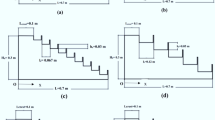Abstract
Stepped spillways are man-made hydraulic structures designed to control the release of flow and to achieve a high energy dissipation. The flow pattern for a given stepped chute geometry can be distinguished into different regimes. Herein, the transition flow regime occurs at a range of intermediate discharges and is characterised by strong hydrodynamic fluctuations and intense splashing next to the free-surface. Up to date, only minimal experimental data is available for the transition flow. As this flow regime is likely to occur on stepped spillways designed for skimming flow operation, a knowledge of the transition flow characteristics is important to ensure safe operation. The present article investigates the hydraulics of the transition flow regime on a laboratory spillway, presenting a detailed characterisation of air–water flow properties and an image-based analysis of pool depth fluctuations within successive step-cavities. The results show two different void fraction and turbulence intensity profiles, indicating the existence of an upper and a lower transition flow sub-regime. The image-based analysis suggests the presence of a rapidly and a gradually varied flow region downstream of the inception point for both sub-regimes, whereas full equilibrium flow was not reached in the physical model. Overall, the study contributes towards improving the characterisation of the transition flow by assembling analytical solutions for different two-phase flow parameters, including void fraction, interfacial velocity and step-cavity pool height.














Similar content being viewed by others
References
Bollrich G (2007) Technical hydromechanics (in German), 6th edn. Huss-Medien, Berlin
Bung DB (2013) Non-intrusive detection of air–water surface roughness in self-aerated chute flows. J Hydraul Res 51(3):322–329
Chamani BMR, Rajaratnam N (1999) Onset of skimming flow on stepped spillways. J Hydraul Eng 125:969–971
Chanson H (1996) Prediction of the transition nappe/skimming flow on a stepped channel. J Hydraul Res 34(3):421–429
Chanson H (2001) The hydraulics of stepped chutes and spillways. Balkema Publishers, Leiden, The Netherlands
Chanson H, Bung D, Matos J (2015) Stepped spillways and cascades. In: Chanson H (ed) Energy dissipation in hydraulic structures. IAHR monograph. CRC Press, Leiden, The Netherlands
Chanson H, Carosi G (2007) Advanced post-processing and correlation analyses in high-velocity air–water flows. Environ Fluid Mech 7(6):495–508
Chanson H, Gonzalez CA (2005) Physical modelling and scale effects of air–water flows on stepped spillways. J Zhejiang Univ Sci 6A(3):243–250
Chanson H, Toombes L (2001) Experimental investigations of air entrainment in transition and skimming flows down a stepped chute. Technical report, The University of Queensland, School of Civil Engineering, Brisbane, Australia
Chanson H, Toombes L (2002) Air–water flows down stepped chutes: turbulence and flow structure observations. Int J Multiph Flow 28(11):1737–1761
Chanson H, Toombes L (2004) Hydraulics of stepped chutes: the transition flow. J Hydraul Eng 42(1):43–54
Elviro V, Mateos C (1995) Spanish research into stepped spillways. J Hydropower Dams 2(5):61–65
Felder S, Chanson H (2015) Phase-detection probe measurements in high-velocity free-surface flows including a discussion of key sampling parameters. Exp Thermal Fluid Sci 61:66–78
Felder S, Chanson H (2017) Scale effects in microscopic air–water flow properties in high-velocity free-surface flows. Exp Thermal Fluid Sci 83:19–36
Fratino U (2004) Nappe and transition flows over stepped chutes. In: Proceedings of the international workshop fluvial, environmental and coastal developments in hydraulic engineering, pp 99–114
Kipphan H (1977) Determination of transport parameters in multiphase flows using correlation measurement techniques (in German). Chem Ing Tech 49(9):695–707
de Marinis G, Fratino U, Piccinni AF (2000) Dissipation efficiency of stepped spillways. In: Minor H (eds) Hydraulics of stepped spillways. Rotterdam, pp 103–110
Matos J (2000) Discussion of “Onset of skimming on stepped spillways” by M.R. Chamani & N. Rajaratnam. J Hydraul Eng 127(6):519–525
Ohtsu I, Yasuda Y (1997) Characteristics of flow conditions on stepped channels. In: Proceedings of the 27th IAHR Biennal Congress. Theme D, San Francisco, pp 583–588
Pfister M, Chanson H (2014) Two-phase air–water flows: scale effects in physical modeling. J Hydrodyn 26(2):291–298
Pfister M, Chanson H, Heller V (2012) Scale effects in physical hydraulic engineering models. J Hydraul Res 50(2):244–246
Pinhero AN, Fael CS (2000) Nappe flow in stepped channels—occurrence and energy dissipation. In: Minor Hager (ed) Hydraulics of stepped spillways. Balkema, Rotterdam, pp 119–126
Takahashi M, Ohtsu I (2012) Aerated flow characteristics of skimming flow over stepped chutes. J Hydraul Res 50(4):427–434
Takehara K, Etoh T (1999) A study on particle identification in PTV—particle mask correlation method. J Vis 1(3):313–323
Toombes L (2002) Experimental study of air–water flow properties on low-gradient stepped cascades. Ph.D. thesis, University of Queensland
Yasuda Y, Ohtsu I (1999) Flow resistance of skimming flow in stepped channels. In: 28th IAHR congress, B14. Graz, Austria
Zhang G (2017) Free-surface aeration, turbulence, and energy dissipation on stepped chutes with triangular steps, chamfered steps, and partially blocked step cavities (under examination). Ph.D. thesis, University of Queensland
Zhang G, Chanson H (2017) Self-aeration in the rapidly- and gradually-varying flow regions of steep smooth and stepped spillways. Environ Fluid Mech 17(1):27–46
Acknowledgements
The authors acknowledge the technical assistance of Jason Van Der Gevel and Stewart Matthews (The University of Queensland). Matthias Kramer was supported by DFG Grant No. KR 4872/2-1.
Author information
Authors and Affiliations
Corresponding author
Rights and permissions
About this article
Cite this article
Kramer, M., Chanson, H. Transition flow regime on stepped spillways: air–water flow characteristics and step-cavity fluctuations. Environ Fluid Mech 18, 947–965 (2018). https://doi.org/10.1007/s10652-018-9575-y
Received:
Accepted:
Published:
Issue Date:
DOI: https://doi.org/10.1007/s10652-018-9575-y



